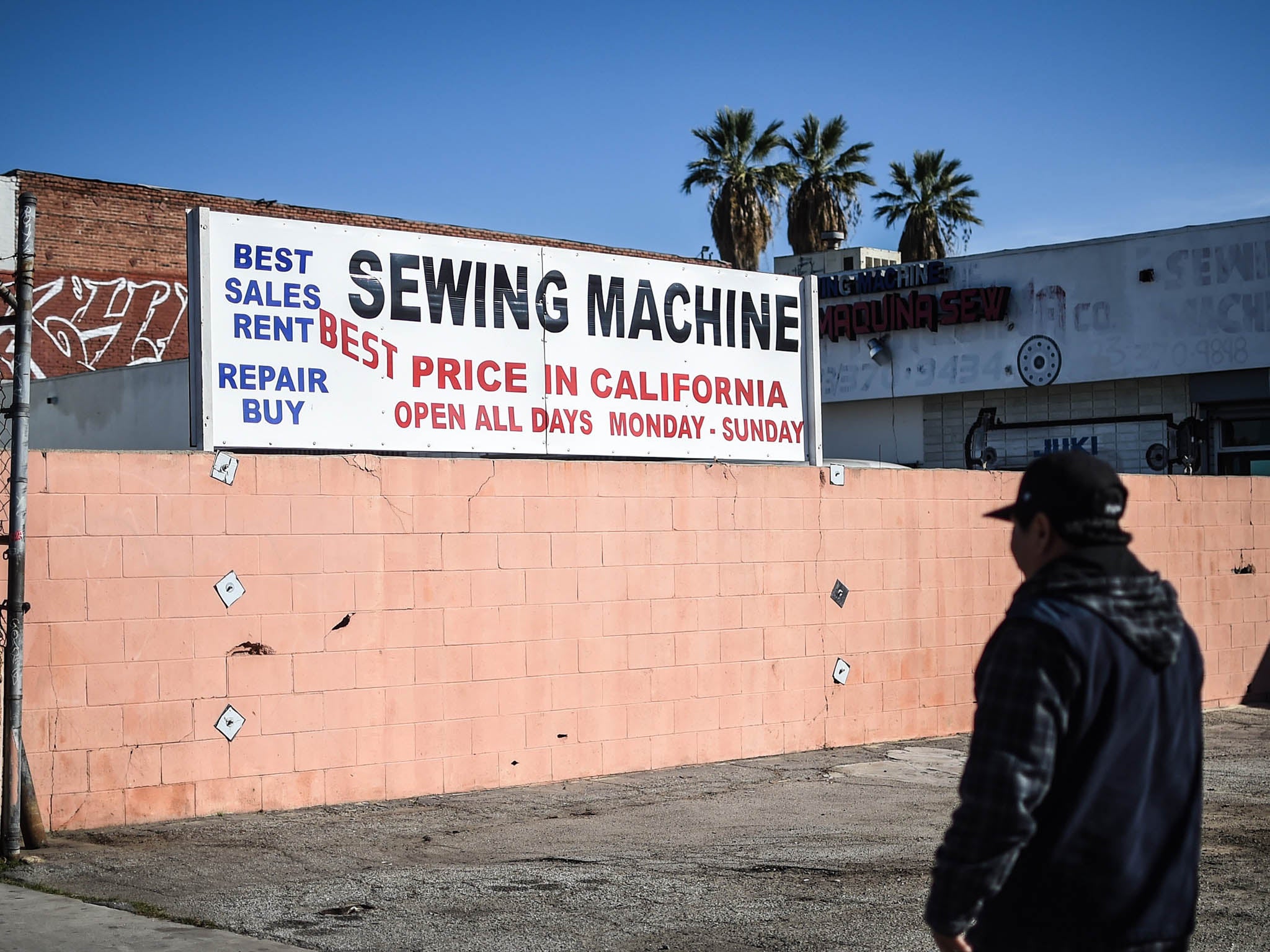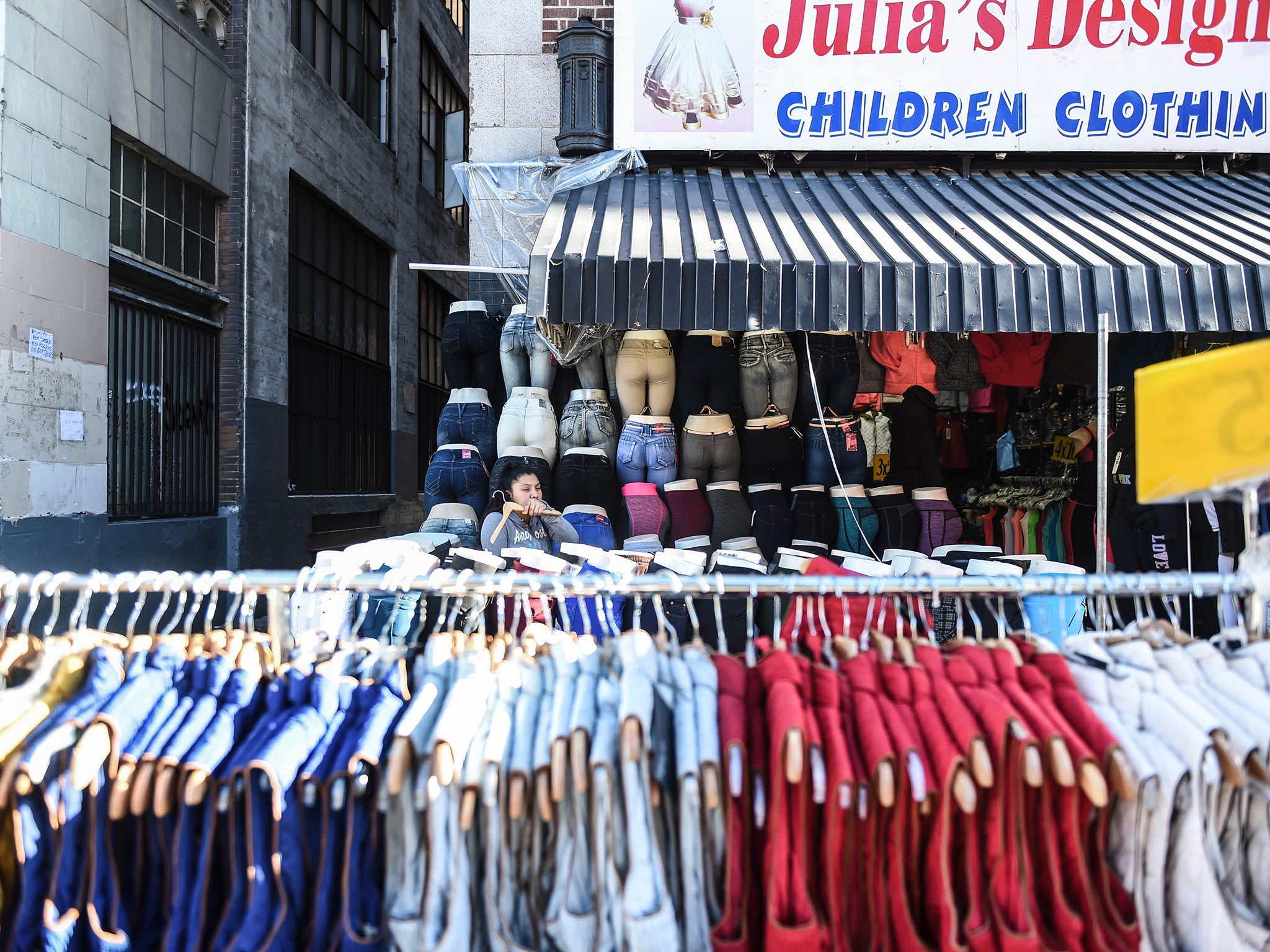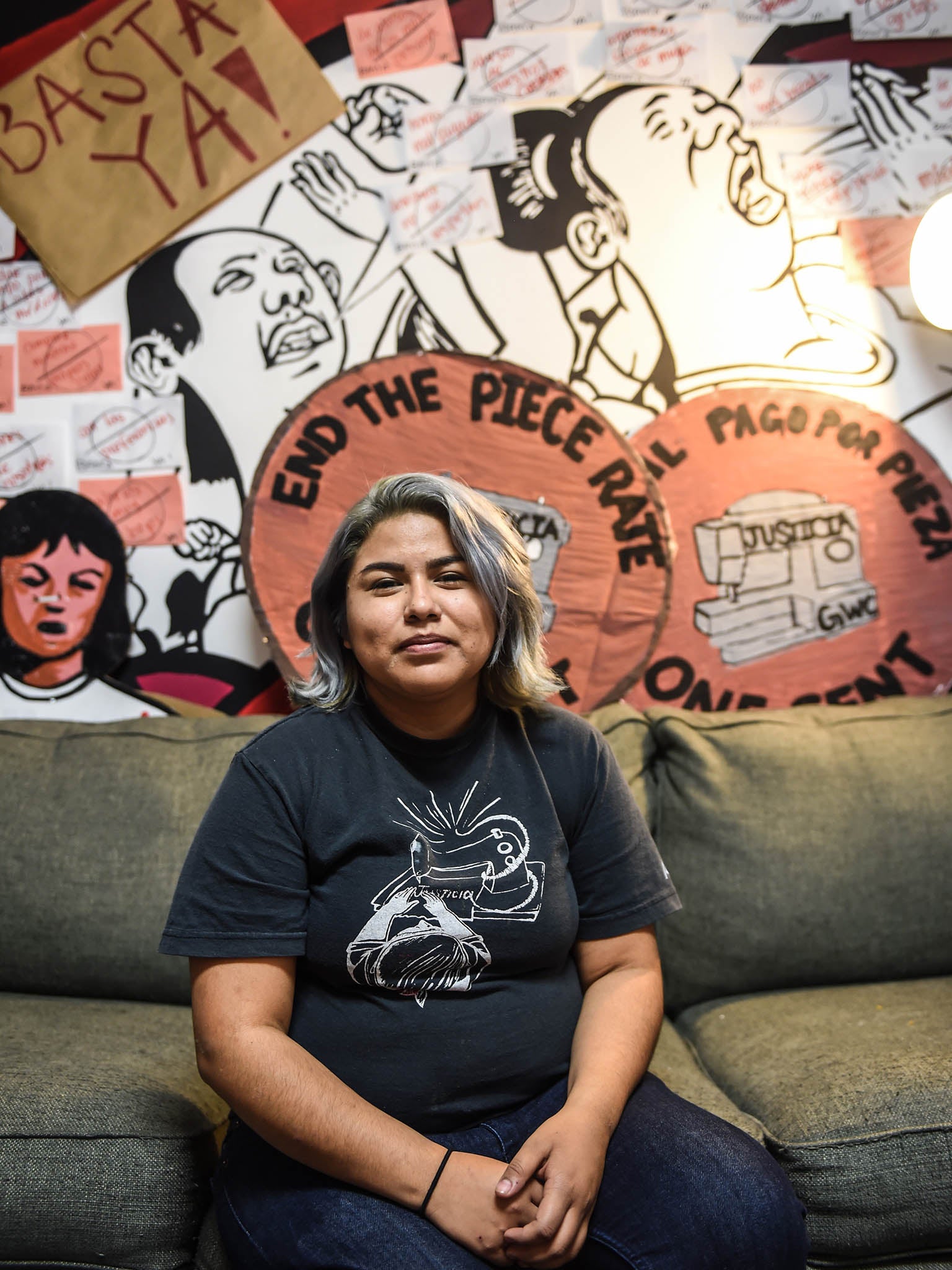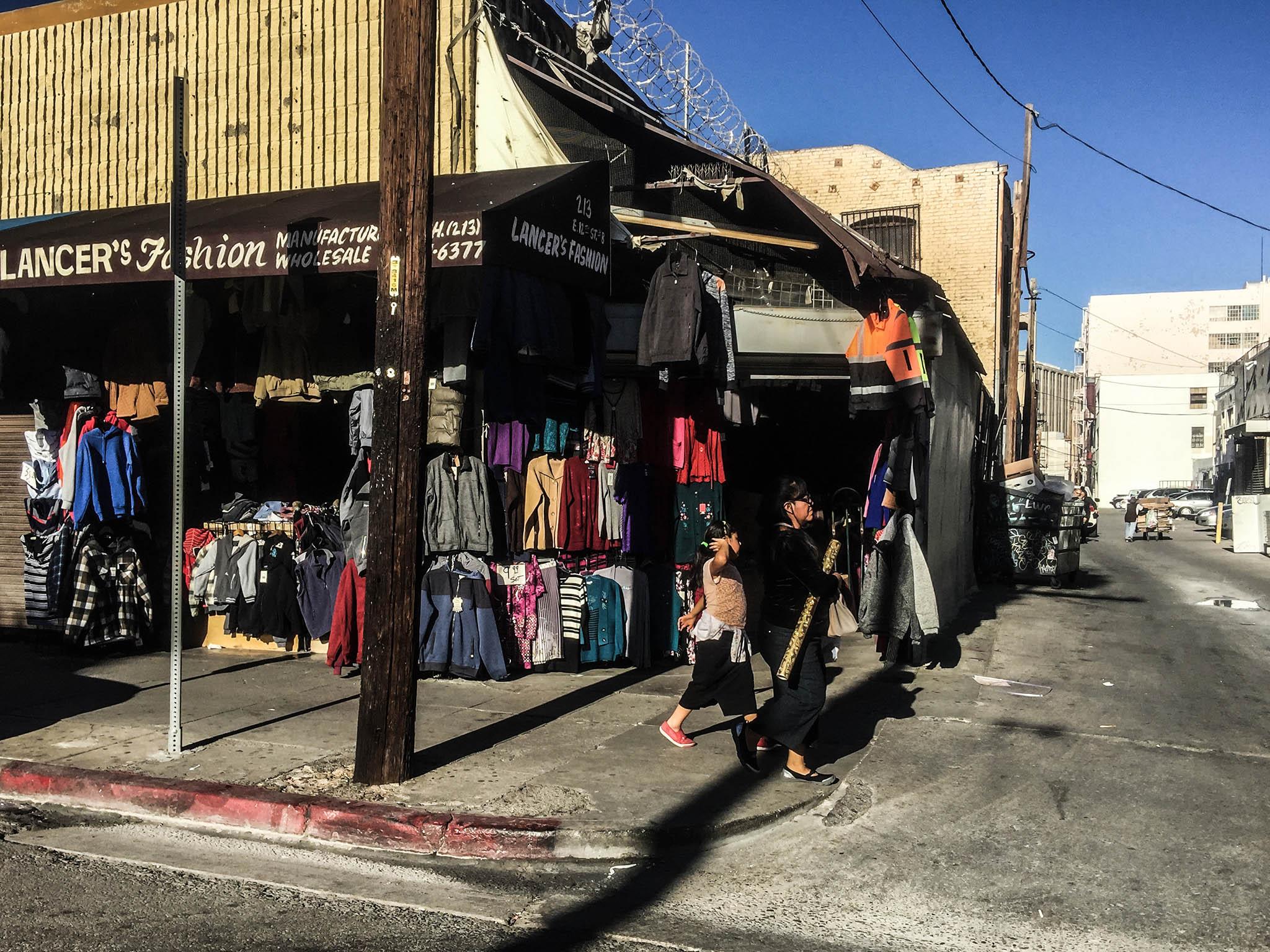Slave labour: the hidden cost of made-in-America retail bargains
Mexican immigrants in the clothing industry face the double threat of being underpaid and undercut by Asian labour rates

Your support helps us to tell the story
From reproductive rights to climate change to Big Tech, The Independent is on the ground when the story is developing. Whether it's investigating the financials of Elon Musk's pro-Trump PAC or producing our latest documentary, 'The A Word', which shines a light on the American women fighting for reproductive rights, we know how important it is to parse out the facts from the messaging.
At such a critical moment in US history, we need reporters on the ground. Your donation allows us to keep sending journalists to speak to both sides of the story.
The Independent is trusted by Americans across the entire political spectrum. And unlike many other quality news outlets, we choose not to lock Americans out of our reporting and analysis with paywalls. We believe quality journalism should be available to everyone, paid for by those who can afford it.
Your support makes all the difference.He had spent his latest 45-hour working week hunched over a sewing machine, attaching labels and stitching collars and tightening black and gold blouses that would soon sell at bargain prices at a popular retailer. But now it was Saturday afternoon, pay day, when Pedro felt the full sting of that bargain: it was his own salary that helped keep the prices down for consumers.
His manager gathered the 30 or so workers from their stations in the unmarked brick building and passed out pay-slips. For the week, he said, he had been paid $225 (£183). Or $5 (£4) per hour. “There's nothing to do but take it,” Pedro said. While immigrants often face criticism for “stealing” jobs, they are the ones being increasingly undercut in America’s clothing industry, forced to accept wages below the legal minimum as retailers fight to pass on bargain prices to consumers.
Federal regulators have uncovered a widespread practise of garment workers, most of them undocumented, being paid below the legal minimum wage, according to a recent Department of Labour report. Those findings were echoed in interviews with workers and workers’ activists here.
“It’s almost been a perfect storm for the garment industry,” said Ruben Rosalez, a regional administrator at the Department of Labour’s wage and hour division, based in San Francisco. “Not only do [the employers] have the pricing pressure, but they have a labour force that's prone to being exploited. They're using that, taking advantage of these workers.”
For two decades, garment factories, most clustered in Los Angeles, have produced clothing for some of America's leading retailers, who have kept production in the US to avoid transportation time and costs and to benefit from higher quality manufacturing processes.
But immigrants who once moved from poorer countries to the US for economic opportunity are now watching their prospects falter as they compete against lower-cost hubs such as Bangladesh, Vietnam and Mexico. As the number of US-based garment jobs decline, those workers also compete against one another, fighting for scarce and low-paying work while fearing deportation if they complain about the pay.
According to the recent Labour Department report, clothing prices at many retailers would have to rise nearly 40 per cent for workers to be paid the minimum wage. The garments made by underpaid workers most often get sold at fast fashion or discount retailers like Forever 21, TJ Maxx, and Ross Dress for Less, according to the Labour Department.
The typical garment worker is somebody like Pedro, a Mexican who slipped over the hills around Tijuana in 1986, spent his first American night in the back of the trunk, arrived in Los Angeles the next morning, found a garment job soon after, and only now, at age 48, was wondering why things had gotten so hard. Pedro, who is still undocumented, requested that his last name not be used out of fear of deportation.
He lived in a small apartment with two other men, barred by his landlord from inviting guests, including his girlfriend. He took bus rides to work and wore the same hooded sweatshirt for days at a time. If he splurged, it was to invite his neighbour to join him at a nearby taco truck with handmade tortillas.

He'd even cut back the money he was sending home to his mother, in Guerrero, Mexico. “I am surviving by sheer force,” he said. While on the clock, Pedro rarely paused. He said he had nimble hands and good eyesight. “I can make it look beautiful,” he said, “but still I have to keep pace.”
Like most garment workers, he said he was paid by the piece, rather than receiving an hourly wage. He earned 4 cents for every label, 2 cents for stitching across the shoulders, 10 cents for a pocket. Such a payment method was legal – but only if the earnings met the minimum wage, $7.25 nationally and $10.50 in Los Angeles. In some jobs over the years, Pedro had earned more than the minimum, but now, he said, those jobs were almost impossible to find.
Few jobs, he said, paid as poorly as the one he'd now held for three months, at a company called Nemo's Apparel Inc. Just as bad, he said, was that he had to sign a pay-cheque that did not reflect the work he actually did: it said he had been on the clock that week for 21 hours, and other pay-slips similarly understated his work. Lawyers and activists say it's a common practise for employers to doctor pay records so that hourly wages appear legal.
“Most of the folks that I see at the wage clinic, it's the same some sort of scheme,” said Mariela Martinez, an organising coordinator the Garment Worker Centre, a nonprofit that advocates for underpaid workers. “What the employer is doing is looking at how much the worker made through the piece rate and then adjusting the hours to approximate that.”
A woman who identified herself as the owner of Nemo's Apparel, reached at a number listed for the company in a California government registry, said her English was too poor for an interview, and that a better English speaker would soon call back. That individual, asked about whether the company pays legal wages, said: “We have nothing to say. I'm going to hang up now.” She did not give her name.
Pedro said Nemo's sews some clothing for Forever 21, as the blouses he helped produce were tagged with the retailer's label. Forever 21 said in a statement that it “takes these issues very seriously and requires all of its vendors to comply with federal and local minimum wage and record-keeping laws.
“While Forever 21 does not own or operate any of the third party vendors or contractors involved, it is our policy and practise to not purchase merchandise from any companies who violate the law,” the retailer said. “Forever 21 condemns any third-party vendor that violates these laws, and takes appropriate action to encourage these independent vendors to improve compliance.”
The parent company of another retailer, TJ Maxx, said in a statement that it “expressly requires our vendors to pay the legally prescribed minimum wage or the prevailing industry wage, whichever is higher, and our vendors must ensure that all subcontractors they use comply with these same requirements.”
A corporate spokeswoman for Ross said the company supports the Labour Department's enforcement efforts, but it “does not control or influence what vendors pay their employees, contractors or subcontractors”.
Federal labour investigators and employers draw a direct connection between the meagre pay for workers – as low as $4 per hour, according to a government report released last month – and the bargain prices paid by consumers. Over the past two decades, consumer prices in real terms have risen more than 50 per cent in the US, according to government data, but clothing costs less today than it did 20 years ago.
As part of its investigation, the Department of Labour in 2016 visited at random 77 garment companies throughout southern California. At 85 per cent of those places, they reported finding labour violations – mostly failures to pay minimum wage.
The sewing companies cluster in several dilapidated neighbourhoods around downtown Los Angeles. Inside block after block of one- and two-storey brick buildings, thousands of workers crouch over sewing machines that hum and pop. Inside, dust fills the air. Windows are covered by grates or bars. Factory entrances are hidden in alleyways or parking lots.
“There are some buildings with multiple factories inside,” said Julie Su, California's labour commissioner. “Sometimes they don't even have a suite number.”
The sewing of clothing depends on a hierarchy of immigrants, according to those who monitor or work in the industry. Hispanics, mostly Mexicans, perform the labour at factories owned often by first- and second-generation Koreans.
Eric Choe, outgoing president of the Korean-American Garment Industry Association, acknowledges that minimum wage violations occur in the industry, but argues that retailers bear at least some of the blame. Those companies, he said, liked American-made goods because they could reach clothing racks more quickly.
“But they want Bangladesh prices,” Choe said. “We're competing with countries where the minimum wage is not even $2.”

Employers say they are in a bind. California's minimum wage is set to gradually rise to $15 per hour by 2022, one of the most generous in the country. In th meantime, the state says it has toughened penalties for wage violations. In 2015, Pedro said he was working at Han's Fashion, another sewing factory, when federal investigators appeared. The investigation prompted Han's to quickly close, and Pedro – with the help of the Garment Worker Center – pressed a claim for unpaid wages with the state.
He'd worked at Han's for three years. According to paperwork he filed with the state, he was owed $16,230 in unpaid wages and overtime.
On a Tuesday in December, Pedro showed up in downtown Los Angeles to the Office of the State Labour Commissioner for a settlement conference – a chance, maybe, to get some of the money he believed he was owed. The number of wage claims made by California garment workers has more than tripled over the past six years, and most claims lead to a scene like this: another morning in a crowded government waiting room where a poster on the wall read, “We put earned wages into workers' pockets”.
But it often doesn't work out like that. The conferences are sit-downs in which workers bargain with their employers, as well as companies higher up on the supply chain, to try to reach a deal and avoid a court case.
Under California law, each of those parties on the supply chain is initially listed as being responsible to help repay the lost wages. But the bigger companies rarely show up to the settlements, lawyers say, and later convince hearing officers they weren't aware of the wage violations. The smaller companies, too, rarely show up to the settlements, and the people running those companies tend to disappear or declare bankruptcy if ordered to make payouts.
Only about 20 per cent of workers that receive a court-ordered payment actually collect money, said Sebastian Sanchez, a lawyer for public interest law firm Bet Tzedek, which works on wage cases. “So the settlement is a huge opportunity for someone in a precarious situation to get money,” Sanchez said.

Su, the California labour commissioner, said in a statement that enforcing penalties against employers “is certainly a challenge”, particularly in the garment industry where violators tend to be “relatively small, fly by night, and open and shut down with some frequency”. She said the state government, though, was confiscating garments made in unlicensed factories and trying to pay workers for lost wages from a government fund created with registration fees from garment companies.
For his case, Pedro had teamed up with four other former-Han's employees, including two of his close friends. Along with a lawyer and Martinez, they sat down at in a windowless conference room and said they were owed more than $100,000 – not just Han's but other manufacturers and retailers too.
Of the 10 companies asked by the Labour Commission to appear for the conference, only two showed up.
Han's Fashion was a no-show. No phone number was available for Han's in a state directory, and individuals listed in wage complaints as being associated with the company could not be reached for comment. Phone numbers listed for those individuals were disconnected or not working.
The two companies at the settlement said they'd worked with Han's only briefly and would pay just a little money to make things right. “They were low-balling us the whole time,” Sanchez said. The sides bargained for three hours, and when it was over, Pedro came away with just $700. The highest payout was $3,500.
“I can pay some bills,” he told the others with a shrug. The others stayed longer to chat, but Pedro quickly said goodbye. It was nearly lunchtime. He said he had to hurry back to Nemo's for work.
Join our commenting forum
Join thought-provoking conversations, follow other Independent readers and see their replies
Comments